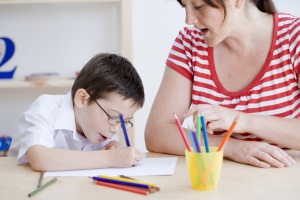How Can I Support Students With Dysgraphia?
Posted by PLB Blogger · Leave a Comment

 Dysgraphia is a developmental disorder that may be caused due to impairment of the child’s motor skills, visual-spatial perceptual skills and in some cases language processing skills. A student with dysgraphia may exhibit illegible writing, difficulty in forming certain letters, inaccurate positioning on the lines and spacing between letters and words, difficulty in spelling and writing down thoughts.
Dysgraphia is a developmental disorder that may be caused due to impairment of the child’s motor skills, visual-spatial perceptual skills and in some cases language processing skills. A student with dysgraphia may exhibit illegible writing, difficulty in forming certain letters, inaccurate positioning on the lines and spacing between letters and words, difficulty in spelling and writing down thoughts.
How to identify signs of dysgraphia?
Some of the early signs that might indicate a child is having difficulty with writing are: inappropriate grasping of a pencil (too tightly or too close to the nib, using all his fingers to stabilize the pencil), awkward use of wrist and body to assist in writing, difficulty in forming some letters, inability to write within lines or margins and incorrect spacing between letters and words.
As the child progresses to being a student at school, these signs become more pronounced with student developing illegible handwriting, laborious writing, saying words aloud while writing, inconsistencies in the writing pattern (mixing up print and cursive writing), omitting letters and words etc.
The student will also show discrepancies in writing down thoughts accurately and will have difficulty in both, copying from the board and while dictating. This might lead to inconsistencies and gaps in his note taking abilities.
How can we help?
Sometimes we might encounter students with Dysgraphia. The first step would be to refer this child to an appropriate specialist like an occupational therapist or a special education consultant so that the child may receive specialized intervention. In addition, there are some things teachers may do in the classroom to support the students. The primary approaches to supporting a student with dysgraphia include Accommodation, Modification and Remediation. While most teachers can easily implement accommodations and modifications, you may need the support of a specialist to implement remediation strategies.
Accommodations: These are various changes that can be included in writing tasks to facilitate learning. These changes can be brought about mainly in the rate, volume, complexity, tools and format of writing and the product.
Changes in the rate of writing include allotting more time (a head start or extra time) or a special library to complete class notes, assignments, exams etc.
Volume adjustments include providing an outline with headings for note taking, worksheets that saves from copying from the board, using a scribe who will write verbatim for the student, using abbreviations while note taking etc.
Teachers can downgrade the complexity of the assignment by not focusing on spelling or neatness as a criterion for scoring, allowing the student to submit the content in parts or by not specifying on a word content etc.
Tools and format changes that can be incorporated include acceptance of typed works, creative representations of the information, using color papers and pens for highlighting information, using papers with raised lines to assist in neat writing, writing in the format (print/cursive) that the student knows best, using graph papers to assist in mathematics etc.
Modifications: In this strategy we aim at reducing the expectations and the stress related to writing assignments. For this, we can incorporate changes like allowing the student to answer multiple choices, answering in two- three sentences, or oral answering instead of essay writing and to focus on the main points rather than descriptive style, using recorders to tape classes and presentations etc.
Remediation: These include techniques by which we can train the student to improve their handwriting and writing skills. You may support the interventions already being done by a specialist. Some ideas that specialists recommend for the classroom include using the proper writing tools (with grippers), encouraging good body mechanics (teacher can draw an outline on the table inside which the student should place his paper), using multi-sensory techniques and big arm movements while teaching letters to facilitate motor memory or having a print out of the same on the desk for future reference, using double spaced papers and graph papers to assist in proper spacing of letters and numbers and using a checklist or mind-maps to help structure and complete assignments.
Use of Assistive Technology like abbreviation expander, spell-check, word processors, voice-activated software’s etc can also be encouraged to help simplify and make easy the process of writing.
Discuss here: How can you motivate the reluctant writers in your classroom?
Learn more: Take a course



